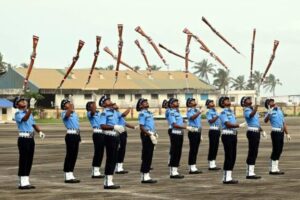Can I join the Air Force with a bad vision? What if I wear glasses? How much eyesight do I need to join the Indian Air Force? If these are the questions running through your mind, you’re not alone! Many aspirants wonder whether their eyesight could be a barrier to fulfilling their dream of joining the Air Force.
Well, don’t worry—this blog will clear up all your doubts! We’ll break down the vision requirements for different Air Force branches, explain whether wearing glasses is allowed, and tell you everything you need to know about LASIK surgery and eye power limits. Let’s dive in and get you one step closer to your Air Force career!
Contents
EyeSight Required To Join Indian Air Force (Different Branches)

When it comes to joining the Indian Air Force, the vision standards vary depending on the branch you’re applying for. Whether you’re aiming for the Flying Branch, Technical Branch, or Ground Duty, each has specific requirements to ensure that your eyesight meets the necessary standards for the role. Let’s break down the vision requirements for each branch.
Flying Branch Vision Requirements

Perfect Vision Needed: For the Flying Branch, perfect vision is mandatory. The required vision standard is 6/6 in both eyes without glasses.
No LASIK or PRK Allowed: If you have undergone LASIK or PRK (laser eye surgery), it is not allowed for this branch. However, flapless surgeries like Smartsurf and CustomEyes AI are not detected in the Air Force medical and may be an option for you.
Important Note: Any kind of vision correction surgery (such as LASIK) should ideally have a waiting period of 12 months before you apply to any branch of the Air Force.
Technical and Ground Duty Vision Requirements
Corrected Vision Allowed: For the Technical and Ground Duty branches, the vision requirement is less strict. You need to have corrected vision of 6/6, which means you can wear glasses or contact lenses.
Refractive Error Limits: A refractive error (the power of your glasses or contacts) up to -3.5 diopters is permitted. This means that if you have mild nearsightedness or farsightedness, you can still apply, as long as your vision is corrected with glasses or lenses.
For a better understanding refer to the table below:
| SL No | Med Cat | Branch | Maximum Limits of Refractive Error | Visual Acuity (VA) with Maximum Correction | Colour Vision |
|---|---|---|---|---|---|
| 1 | A1G1 | F(P) including WSOs/CSOs, Flying Branch Cadets at NDA and AFA | Hypermetropia: +1.5 D Sph, Myopia: Nil, Astigmatism: +0.75 D Cyl (within +1.5 D Max), Retinoscopic Myopia: Nil | 6/6 in one eye and 6/9 in other, correctable to 6/6 both eyes only for Hypermetropia | CP-I |
| 2 | A4G1 | Aircrew other than F(P) | Hypermetropia: +3.5 D Sph, Myopia: -2.0 D Sph, Astigmatism: +0.75 D Cyl | 6/24 in one eye and 6/36 in other, correctable to 6/6 both eyes | CP-I |
| 3 | A4G1 | Adm/ATC/FC/WS | Hypermetropia: +3.5 D Sph, Myopia: -3.50 D Sph, Astigmatism: +2.50 D Cyl | Correctable to 6/6 in each eye. Wearing of glasses will be compulsory when visual acuity is below 6/6 | CP-II |
| 4 | A4G1 | AE(M)/ AE(L) | Hypermetropia: +3.5 D Sph, Myopia: -3.50 D Sph, Astigmatism: +2.50 D Cyl | Corrected visual acuity must be 6/6 in each eye. Wearing of glasses will be compulsory when advised | CP-II |
| 5 | A4G1 | Met | Hypermetropia: +3.5 D Sph, Myopia: -3.50 D Sph, Astigmatism: +2.50 D Cyl | Corrected visual acuity must be 6/6 both eyes. Wearing of glasses will be compulsory | CP-II |
| 6 | A4G1 | Accts/Lgs/Edn | Hypermetropia: +3.5 D Sph, Myopia: -3.50 D Sph, Astigmatism: +2.50 D Cyl | Corrected visual acuity must be 6/6 both eyes. Wearing of glasses will be compulsory | CP-II |
| 7 | A4G1 | 10+2/NDA Entry to ground Duty Branches of IAF (AE(L)/ADM/LGS) | Hypermetropia: +2.5 D Sph, Myopia: -2.50 D Sph, Astigmatism: +2.0 D Cyl | Uncorrected VA 6/36 and 6/36, Corrected VA 6/6 and 6/6 | CP-II |
Visit: INDIAN AIR FORCE | भारतीय वायु सेना
Can You Join the Air Force with Glasses or Contact Lenses?
Yes, you can join the Air Force with glasses or contact lenses for Technical and Ground Duty roles, as long as your vision is corrected to 6/6.
However, for the Flying Branch, perfect vision without glasses is required. Glasses or contacts are not allowed to meet the vision standard for pilots.
Common Eye Conditions That May Disqualify You from the Air Force
Here’s a summary of various eye conditions and whether they may disqualify you from joining the Air Force, based on the clinical examination findings:
- Color blindness is a disqualifying condition across all branches of the Air Force, as accurate color perception is crucial for many operational duties.
- If you have night blindness, it can be a reason for disqualification from any branch, especially the Flying Branch, where clear vision in all lighting conditions is critical.
- Other severe visual impairments (below in the table)
| Eye Condition | Fit or Unfit | Notes |
|---|---|---|
| Ptosis (Drooping Eyelid) | Fit (mild) / Unfit | Mild ptosis is acceptable with no visual impact. Severe cases or those with aberrant degeneration are unfit. |
| Exotropia (Outward Squint) | Unfit | |
| Anisocoria (Unequal Pupils) | Unfit | If the pupil size difference is >1mm. |
| Heterochromia (Different Colored Irises) | Unfit | |
| Sphincter Tears | Fit (if ≤ 1mm pupil difference) | Pupillary reflexes should be brisk, and no pathology in cornea, lens, or retina. |
| Pseudophakia (Artificial Lens Post-Cataract) | Unfit | |
| Blepharitis | Unfit | Particularly with loss of eyelashes. |
| Ectropion/Entropion (Eyelid Disorders) | Unfit (mild cases may be fit) | Mild cases that do not affect daily functioning may be considered fit on appeal. |
| Pterygium (Growth on the Eye) | Unfit (unless regressive, non-vascularized) | Non-threatening pterygium less than 1.5mm on peripheral cornea may be fit after measurement. |
| Nystagmus (Involuntary Eye Movements) | Unfit (except physiological nystagmus) | |
| Corneal Scars/Opacities | Unfit | Progressive corneal disorders such as Keratoconus are unfit. Corneal scars may be fit if they do not interfere with vision. |
| Lenticular Opacities (Cataracts) | Unfit | Small, stationary opacities in the peripheral cornea may be fit if not affecting the visual axis. |
| Optic Nerve Drusen | Unfit | |
| High Cup-Disc Ratio | Unfit | If there is significant asymmetry between eyes or any defects in the Retinal Nerve Fiber Layer (RNFL). |
| Retinal Lesions | Fit (if peripheral) / Unfit (if central) | Small healed scars in the periphery are fit, but any lesion in the central retina is unfit. |
| Lattice Degeneration | Fit (under specific conditions) / Unfit | Unfit if extensive or with holes/flap tears, fit if limited to small, stable areas without complications. |
| Keratoconus | Unfit | |
| Myopia (Nearsightedness) | Unfit (outside prescribed limits) | Unfit even with corrected vision if there is a family history or the condition is progressive. |
| Refractive Surgeries (LASIK, PRK, SMILE) | Fit (under conditions) / Unfit | Must meet strict requirements like post-surgery stability and corneal thickness; Radial Keratotomy is unfit. |
| Cataract Surgeries | Unfit | |
| Other Eye Surgeries | Unfit | Includes surgeries like C3R, INTACS, and retinal surgeries. |
These eye conditions can either make you fit or unfit depending on their severity, treatment history, and impact on vision. If you have any of these conditions, it’s important to consult with an eye specialist and get a detailed assessment before applying to the Air Force.



